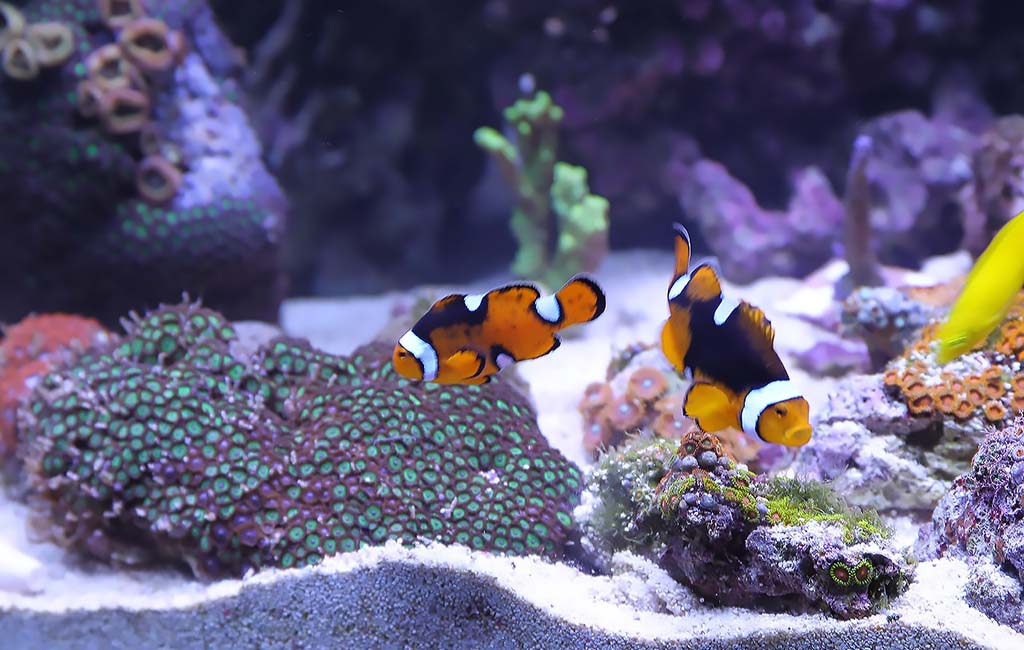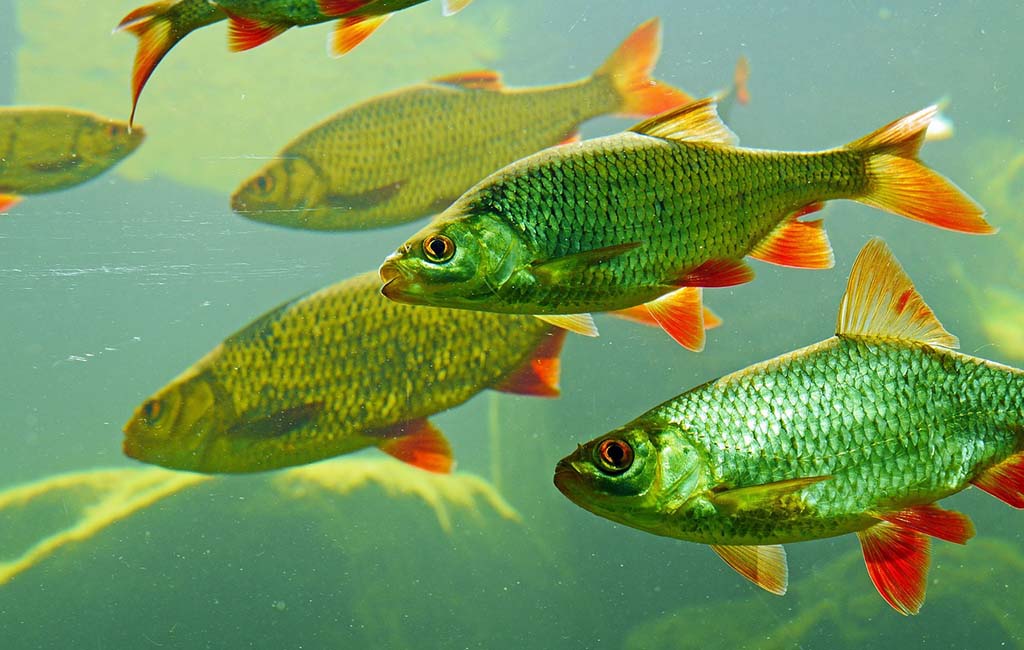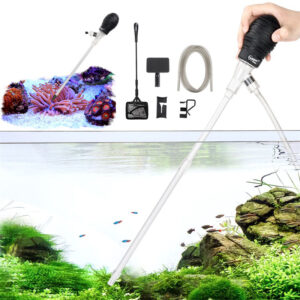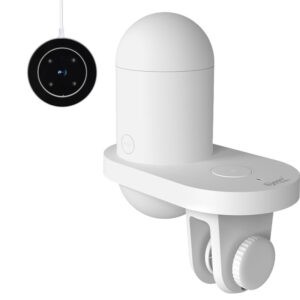Do you know how much to feed fish? Yes or no, or still confused. In any aspect, this article will help you to optimize fish feeding. You will learn about fish feeding calculation, how much, and how to feed your fish. Moreover, the feeding rules are also worth knowing. You’ll also find two products that will make your aquarist life easy. So, scroll down and enjoy it.
Content Table
Do You Know How Much to Feed Your Fish?
If you have an aquarium, you must know the answer to this question. Overfeeding or underfeeding both have the worst consequences. In severe cases, it can cause fatality.

How much to feed fish
Aquarium Fish Feeding Rule and Ratio
Feeding Rule
- Supply only such a quantity that the fish can consume within 2 to 3 minutes. Otherwise, it’ll cause problems in the tank, i.e., waste, ammonia spike, etc.
- Set the feeding frequency according to the fish Generally, adults require one, predatory fish requires 1 to 3, and fry requires 3 to 5 feedings daily.
- Herbivores frequently require small feedings. Carnivore species require a less frequent, high-protein diet.
- Always keep on balancing your feed. The same food causes a loss of interest in feeding.
- Always feed high-quality food to avoid malnutrition.
- Feed your bettas and goldfish once a week. It will help improve digestion and reduce the risk of bloating.
Feeding Ratio
It’s a percentage of a fish’s body weight that should be fed daily. It varies with age, species, and water temperature. Here is the general idea of the feeding ratio.
| Type | % feeding ratio | Feeding frequency |
| Juvenile | 5 to 8 percent of body weight | 4 to 5 times daily |
| Fingerlings | 5% of body weight daily | 3 to 4 times daily |
| Production/Brood stock (Adults) | 1-3% of body weight daily | 2 to 3 times daily |
Fish Feeding Calculation
It’s a calculation of the daily feed quantity that one should supply to the tank multiple times. Here is the formula for this.
Daily feed amount = Total fish biomass X feeding ratio (% daily)
While
Total fish Biomass = number of fish X average weight
Feeding Ratio = A percentage of body weight per day
A 5% feeding ratio means that, if your fish weighs about 100 grams, you should feed 5% of its total weight. It means 5 grams daily.
What Is Proper Fish Feeding?
Efficiently feeding your fish is necessary. Throwing all feed at once can cause numerous issues, i.e., obesity, ammonia spike, algae bloom, etc. Here are some proper fish-feeding advices.
Feed According to Fish Type
Usually, there are 4 different kinds of fish that aquarists love to raise, i.e., herbivorous, carnivorous, omnivorous, and bottom feeders. Every type has its feeding habits. Here is a general overview of all.
| Type | Requirements |
| Herbivorous | Frequent small feedings, i.e., 2 to 4 |
| Avoid a high-protein diet to avoid digestive issues | |
| Feed on vegetable-based foods, i.e., algae wafers, Zucchini, Cucumber, boiled or steamed Sweet Potato, etc. | |
| Carnivorous | Feed on high-protein foods, i.e., live, frozen, and pellet-based protein foods. |
| Feed once or twice daily and add meaty food options, i.e., brine shrimp, bloodworms, insects, etc. | |
| Avoid overfeeding as it can cause digestive issues. Carnivorous species have slow digestive systems. | |
| Omnivorous | Feed a balanced protein and animal-based diet |
| Feed twice a day | |
| Avoid overfeeding, as overfeeding can cause bloating and damage water quality. | |
| Bottom Feeders | Feed on sinking pellets, fresh-chopped vegetables, and wafers. |
| Most of the bottom feeders are nocturnal, so they feed in the evening. However, you can feed them other times if they are not nocturnal. | |
| Feed them extra, as surface feeders often take a big chunk of their diet. |
Feeding Duration
Always follow the 2-to-3-minute formula, i.e., feed only the quantity that the fish can consume within 2 to 3 minutes. If there are no bottom feeders in your tank, remove the leftover food after 3 minutes. This will help you avoid ammonia spikes, damage to water quality, and many other issues.
Feed According to the Weight
Fry usually have a feed ratio of up to 10%. So, they require frequent and more feeding. This case is reversed in adults. They require less food and seldom feed, i.e., one or two feedings daily.
Consider the Temperature
Fish have a larger appetite at high temperatures than at low temperatures. Therefore, the feed and feeding frequency should be reduced at low temperatures.
Look at the Feeding Behavior
If fish are uninterested in feeding and there is a large leftover food in the tank. Follow the two following advice.
- Adjust the feeding frequency and check the fish’s health.
- Introduce some interesting or favorite fish food.
The Right Amount of Food for Aquarium Fish
Different fish species have different feeding requirements. Moreover, feeding at the right time and in the right amount helps to maintain their health and overall tank environment. Here is a feeding table for the 5 most famous species.
| Species | Age group | Approximate Average Weight (g) | Approximate daily food requirement (g) | Feeding Ratio (%) | Feeding frequency | Foods |
| Bettas | Fry | ~0.02 | 0.001 | 5.0 | 3 to 4 | Infusoria, newly hatched brine shrimp |
| Juvenile | ~1 | 0.05 | 5.0% | 2 to 3 | High-protein micro-pellets, frozen or live foods (e.g., bloodworms) | |
| Adults | ~3 | 0.06 | 2.0% | 1 to 2 | High-protein pellets, frozen or live foods (e.g., bloodworms, brine shrimp) | |
| Neon Tetra | Fry | 0.005 | 0.0003 | 6.0% | 3 to 4 | Infusoria, powdered fry food |
| Juvenile | 0.1 | 0.004 | 4.0% | 2 to 3 | High-quality micro-pellets, finely crushed flakes | |
| Adults | 0.25 | 0.005 | 2.0 | 1 to 2 | High-quality flakes, micro-pellets, occasional live or frozen foods (e.g., daphnia) | |
| Angelfish | Fry | 0.05 | 0.0025 | 5.0 | 3 to 4 | Infusoria, newly hatched brine shrimp |
| Juvenile | 5 | 0.2 | 4.0% | 2 to 3 | High-quality flakes, micro-pellets, live or frozen foods | |
| Adults | 15 | 0.3 | 2.0 | 1 to 2 | Flakes, pellets, live or frozen foods (e.g., bloodworms, brine shrimp) | |
| Guppy | Fry | 0.01 | 0.0005 | 5.0 | 3 to 4 | Infusoria, finely crushed flakes |
| Juvenile | 0.2 | 0.008 | 4.0 | 2 to 3 | High-quality flakes, micro-pellets | |
| Adults | 0.5 | 0.01 | 2.0 | 1 to 2 | Flakes, micro-pellets, vegetable matter, occasional live or frozen foods | |
| Discus | Fry | 0.1 | 0.007 | 7.0 | 3 to 4 | Infusoria, specialized fry food |
| Juvenile | 10 | 0.4 | 4.0 | 2 to 3 | High-protein pellets, live or frozen foods | |
| Adults | 50 | 1.0 | 2.0 | 1 to 2 | High-quality flakes, pellets, live or frozen foods (e.g., bloodworms, beef heart) |
How to Feed Your Fish?
Scattering the food all around the aquarium can cause problems, i.e., difficult to remove the leftover food after 5 minutes. Moreover, calculation every time is hard. Therefore, you should automate the procedure. hygger presents some smart solutions to this fish-feeding problem. Here are some products and how to install them in the tank.
Hygger 082 Fish Feeder
hygger has introduced an advanced automatic fish feeder for aquariums. It provides more control over your vacation fish feeder with a user-friendly app that allows you to feed your fish from anywhere. Here are the features, design, and how to set up this device.
Installation
It’s easy to set up a hygger 082 fish feeder. Follow the following step-by-step procedure.
- Unbox the accessory pack and spread them near you.
- Use the adjustable clip to adjust the feeder on the corner of the tank.
- Attach the feeder to the tank’s lid with the help of stickers.
- Attach the night vision 2K HD camera on the side of the tank.
- Use the C-type USB charger cord to connect it to the electricity resource, i.e., home electricity or a power bank.
- Install the “Smart Life” application from the App Store or Google Play.
- Create an account.
- Press the reset button on the feeder for 5 seconds until the light blinks.
- Open the Smart Life app.
- Click on Add Device. And click on camera & lock, and select the smart camera.
- Click the QR code, select Wi-Fi mode, and select AP mode.
- Enter the network name and password, and press connect.
- Make a feeding schedule by setting the duration and feeding time.
- Set the feeding quantity up to 0.1 grams.
- Use the device to look at the tank.
- Click “manual feed” to manually feed your fish.
- It will send you a food shortage notification on your device screen and blink a red light on the feeder.
- Open the feed basket and fill it with the food.

fish feeding calculation
hygger 090 Fish Feed Ring
hygger Aquarium’s fluorescent feeding ring is a unique product. It has a special oil-resistant film. That film helps to avoid feed floating from the ring. Moreover, it prevents oil-layer formation in the tank, i.e., gaps on the left and right continually expel the oil layer from the ring. Easy installation, assembly, and lightweight make it a suitable fish-feeding option.
How to Install a Fish Feeding Ring
- Place the ring in the desired position.
- Secure the clip to the wall of the aquarium.
- Add food to the tank and let your fish enjoy their meal.
Closing Remarks
The exact feed quantity is necessary for the optimal health of the tank and fish. You can do it by knowing the feed ratio, i.e., varies with age, species, and temperature. It is high for fry and low for the adults. Moreover, some other rules should be followed, such as feeding duration, feeding according to species, and cleaning the leftovers to maintain the water parameters in the tank. Using the feeding ring and intelligent feeder will help you to keep your fish feed supply optimal.


Leave a comment